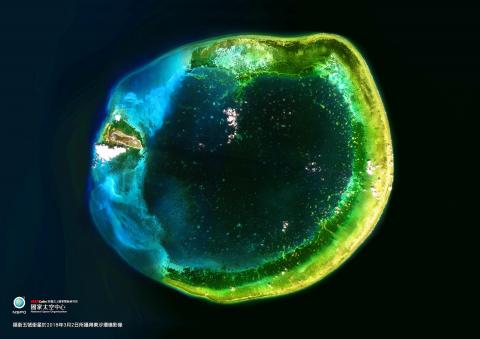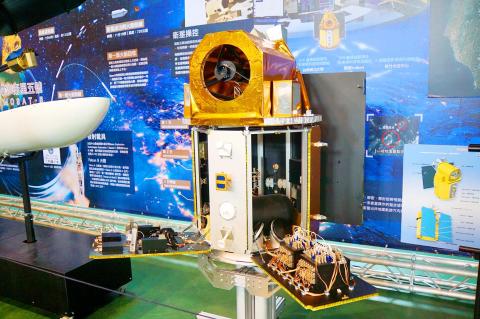The images taken by Taiwan’s first indigenously developed satellite, Formosat-5, has been used to calculate underwater topography and monitor rice production after it became commercially operational last year, and its performance is comparable to that of a US high-resolution satellite, the National Space Organization (NSPO) said yesterday.
The NSPO, a National Applied Research Laboratories affiliate, yesterday at a news conference in Taipei touted the academic applications of images taken by Formosat-5.
The optical remote sensing satellite was launched on Aug. 25, 2017, from Vandenberg Air Force Base in California on a Falcon 9 rocket built by Space Exploration Technologies Corp, commonly known as SpaceX.

Photo courtesy of the National Space organization
It became commercially operational in September last year, and has been transmitting black-and-white images with a resolution of 2m and color images with a resolution of 4m.
Huang Chih-yuan (黃智遠), an associate professor at National Central University’s Center for Space and Remote Sensing Research, said that his team used the satellite images to map the underwater topography around the Pratas Islands (Dongsha Islands, 東沙) using an “artificial neural network” computing method.
Compared with WorldView-2, a commercial imaging satellite with better resolutions, Formosat-5 images only have a margin of error of up to 40cm, meaning the two perform similarly, he said.

Photo: Chan Shih-hung, Taipei Times
Whether the difference matters depends on areas of application, he added.
While the satellite cannot take underwater images as deep as sonar equipment, it can save costs for in situ surveys of places where the topological relief is not that significant, he added.
Chu Tzu-how (朱子豪), a professor at National Taiwan University’s Spatial Information Research Center, said that his team used the satellite images to calculate the areas of rice fields in Taiwan, with an accuracy level of 90.05 percent.
The Agricultural Research Institute in August sparked controversy when it was found to have attempted to buy images sourced from a China-based firm for monitoring crop production.
Only China’s Zhuhai-1 remote sensing satellite constellation could satisfy the institute’s requirements for image resolution better than 10m with more than 30 wavebands, the institute said at the time.
Asked about the issue yesterday, Chu said that purchases of satellite images can be purely commercial transactions, avoiding confidential data.
Countries owning satellites also share information for disaster-relief purposes, he added.
While Formosat-5 has only four wavebands, they are sufficient for most agricultural survey missions, he said.
The NSPO is planning to launch 10 satellites from this year through 2028: six high-resolution satellites, two ultra-high-resolution satellites and two synthetic aperture radar satellites, NSPO Director-General Lin Chun-liang (林俊良) said.
It is also updating its integration and testing facilities for satellite instruments, and preparing standard specification guidelines for the manufacture of related components, Lin added.

People can preregister to receive their NT$10,000 (US$325) cash distributed from the central government on Nov. 5 after President William Lai (賴清德) yesterday signed the Special Budget for Strengthening Economic, Social and National Security Resilience, the Executive Yuan told a news conference last night. The special budget, passed by the Legislative Yuan on Friday last week with a cash handout budget of NT$236 billion, was officially submitted to the Executive Yuan and the Presidential Office yesterday afternoon. People can register through the official Web site at https://10000.gov.tw to have the funds deposited into their bank accounts, withdraw the funds at automated teller

PEACE AND STABILITY: Maintaining the cross-strait ‘status quo’ has long been the government’s position, the Ministry of Foreign Affairs said Taiwan is committed to maintaining the cross-strait “status quo” and seeks no escalation of tensions, the Ministry of Foreign Affairs (MOFA) said yesterday, rebutting a Time magazine opinion piece that described President William Lai (賴清德) as a “reckless leader.” The article, titled “The US Must Beware of Taiwan’s Reckless Leader,” was written by Lyle Goldstein, director of the Asia Program at the Washington-based Defense Priorities think tank. Goldstein wrote that Taiwan is “the world’s most dangerous flashpoint” amid ongoing conflicts in the Middle East and Russia’s invasion of Ukraine. He said that the situation in the Taiwan Strait has become less stable

CONCESSION: A Shin Kong official said that the firm was ‘willing to contribute’ to the nation, as the move would enable Nvidia Crop to build its headquarters in Taiwan Shin Kong Life Insurance Co (新光人壽) yesterday said it would relinquish land-use rights, or known as surface rights, for two plots in Taipei’s Beitou District (北投), paving the way for Nvidia Corp to expand its office footprint in Taiwan. The insurer said it made the decision “in the interest of the nation’s greater good” and would not seek compensation from taxpayers for potential future losses, calling the move a gesture to resolve a months-long impasse among the insurer, the Taipei City Government and the US chip giant. “The decision was made on the condition that the Taipei City Government reimburses the related

FRESH LOOK: A committee would gather expert and public input on the themes and visual motifs that would appear on the notes, the central bank governor said The central bank has launched a comprehensive redesign of New Taiwan dollar banknotes to enhance anti-counterfeiting measures, improve accessibility and align the bills with global sustainability standards, Governor Yang Chin-long (楊金龍) told a meeting of the legislature’s Finance Committee yesterday. The overhaul would affect all five denominations — NT$100, NT$200, NT$500, NT$1,000 and NT$2,000 notes — but not coins, Yang said. It would be the first major update to the banknotes in 24 years, as the current series, introduced in 2001, has remained in circulation amid rapid advances in printing technology and security standards. “Updating the notes is essential to safeguard the integrity